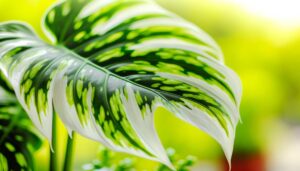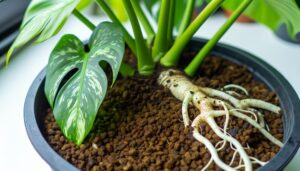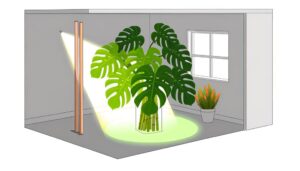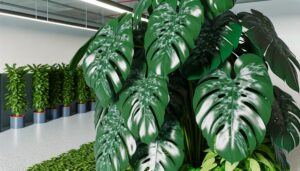Monstera Siltepecana El Salvador Australia
You can grow Monstera Siltepecana from El Salvador in Australia by mimicking its original habitat. Guarantee high humidity (60-80%), indirect light, and temperatures between 18-27°C (65-80°F), utilizing a well-draining soil mix abundant in organic matter.
This species showcases silver variegation and dark green veins, prospering as a climber using aerial roots. Obtain phytosanitary certification and adhere to Australian quarantine regulations when importing.
Monitor for pests like spider mites and mealybugs, and maintain soil moisture consistently. With the appropriate conditions, your Monstera Siltepecana will thrive, unveiling more distinct characteristics and growth patterns.

Key Takeaways
- Monstera Siltepecana from El Salvador requires phytosanitary certification and adherence to Australian quarantine regulations for import.
- It thrives in bright, indirect sunlight and high humidity levels between 60-80%.
- Popular in Australia for its unique fenestrated leaves and adaptability to indoor environments.
- Ideal growing conditions include well-draining soil, consistent moisture, and placement near east or north-facing windows.
- Propagation is best achieved through stem cuttings with nodes and healthy leaves.
Origin of Monstera Siltepecana

Have you ever wondered where Monstera siltepecana, a striking member of the Araceae family, originates?
This enchanting species hails from the tropical rainforests of Central America, particularly found in countries like Mexico, Honduras, and Nicaragua. Monstera siltepecana thrives in understory environments, where it benefits from high humidity and indirect light. The plant's natural habitat includes moist, well-draining soils rich in organic matter.
You'll notice it often climbing trees or spreading across the forest floor, utilizing its aerial roots for support and nutrient uptake. The region's consistent temperatures and ample rainfall create ideal conditions for its growth. Understanding the plant's origin helps in replicating these conditions, enabling you to cultivate a healthy Monstera siltepecana in your own environment.
Unique Features
You'll notice that Monstera siltepecana features distinct leaf patterns with silver variegation and dark green venation, creating a striking contrast.
This species exhibits a unique growth habit, evolving from juvenile to mature leaves with fenestrations as it climbs.
In its native habitat, it often uses trees for support, showcasing its hemiepiphytic nature.
Distinct Leaf Patterns
The Monstera Siltepecana boasts intricate, fenestrated leaves that exhibit a striking contrast between their dark green venation and silvery undersides. You'll notice that the foliage changes dramatically as it matures. Juvenile leaves lack fenestrations, presenting a more uniform texture, while mature leaves develop characteristic perforations, enhancing their ornamental value. The following table provides a detailed comparison:
| Leaf Stage | Characteristics |
|---|---|
| Juvenile | Solid, elongated, no fenestrations |
| Mature | Perforated, elongated, fenestrated |
| Venation | Dark green, pronounced |
| Underside Color | Silvery, reflective |
| Surface Texture | Smooth in juveniles, textured in adults |
This unique patterning is not just visually appealing but also serves functional purposes like optimizing light capture and reducing wind resistance. Understanding these patterns deepens your appreciation for this remarkable species.
Growth Habit
Monstera Siltepecana displays a climbing growth pattern, using its aerial roots to climb trees and other structures in its natural environment. You'll notice it develops long, slim stems (petioles) that help it grip onto vertical surfaces.
As it climbs, it progresses from young to mature leaves, which become more fenestrated and larger. The hemiepiphytic nature allows it to begin life on the ground and climb to the canopy, maximizing light exposure.
Its leaves are usually lance-shaped with distinct silver variegation and dark green veins, adding to its unique appearance. The plant also thrives in high humidity and indirect sunlight, promoting vigorous growth.
Understanding these growth patterns ensures ideal care and propagation in both indoor and outdoor settings.
El Salvador Variety
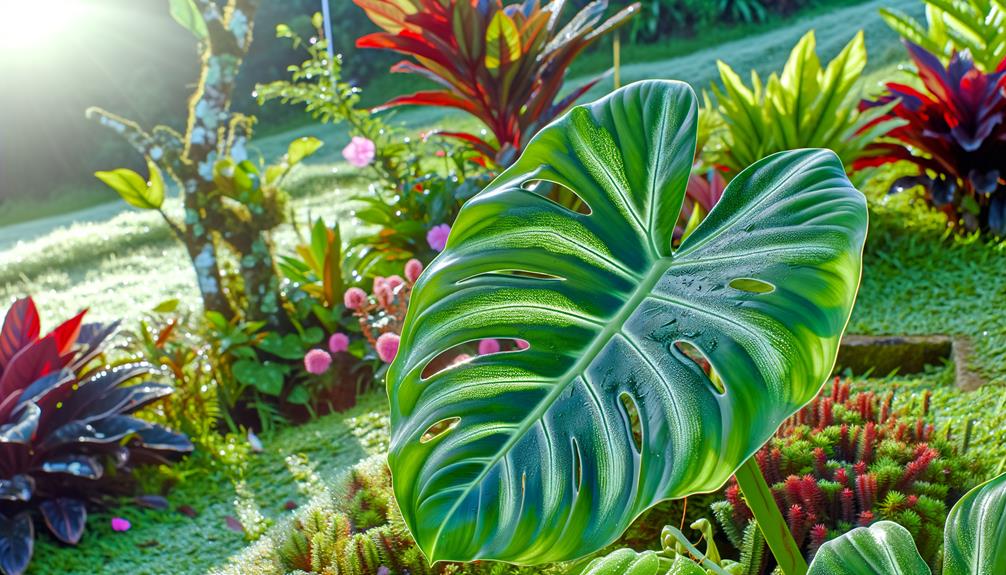
When examining the El Salvador variety of Monstera siltepecana, you'll notice its distinct growth patterns, characterized by fenestrated leaves and rapid climbing tendencies.
Understanding its care requirements, such as ideal humidity levels and soil composition, is essential for maintaining plant health.
Additionally, mastering propagation techniques like stem cuttings and node division will enhance your cultivation success.
Unique Growth Patterns
You'll notice Monstera siltepecana from El Salvador exhibits strikingly unique growth patterns characterized by its rapid climbing ability and distinct leaf fenestration. As an epiphyte, it uses aerial roots to latch onto support structures, allowing it to ascend swiftly.
The juvenile leaves are lanceolate with a silver sheen and prominent dark green veining. As the plant matures, the leaves transform, developing fenestrations—perforations that enhance gas exchange and light penetration. These fenestrations are a hallmark of mature Monstera species, including Monstera siltepecana.
Additionally, you'll observe the internodal spacing decreases as it climbs, promoting denser foliage. This species exemplifies adaptive morphology, optimizing light capture and structural stability within its habitat. Understanding these patterns highlights Monstera siltepecana's extraordinary adaptability.
Care Requirements Overview
Given its exceptional adaptability and unique growth patterns, caring for Monstera siltepecana from El Salvador requires attention to specific environmental conditions and maintenance practices to thrive.
Here's a concise guide:
- Light: Ensure ample, indirect sunlight. Direct sunlight can cause leaf burn in Monstera siltepecana.
- Humidity: Maintain elevated humidity levels (60-80%). Use a humidifier or mist the leaves regularly to replicate its natural habitat.
- Temperature: Keep the temperature between 18-27°C (65-80°F). Avoid sudden temperature changes that could stress the plant.
- Soil: Use well-draining, aerated soil with organic matter. A blend of peat moss, perlite, and orchid bark optimizes root health and growth.
Propagation Techniques Explained
To propagate Monstera siltepecana from El Salvador, you should frequently utilize stem cuttings, making sure each cutting has at least one node and a healthy leaf. First, using sterilized pruning shears, make a clean cut just below a node.
Nodes are essential as they contain meristematic tissue that aids root development. Submerge the cut end in water or a well-draining substrate like perlite to promote root formation. Maintain high humidity and indirect light to optimize growth conditions.
Regularly monitor for root emergence, which typically occurs within 3-4 weeks. Once roots reach 2-3 inches, transplant the cutting into a potting mix comprising peat, perlite, and orchid bark to guarantee aeration and moisture retention.
Journey to Australia
Transporting Monstera siltepecana from its native habitat in El Salvador to the diverse climates of Australia involves careful planning and adherence to biosecurity protocols. You'll need to navigate a series of steps to achieve the plant's safe arrival while preventing the introduction of pests and diseases.
- Phytosanitary Certification: Obtain a phytosanitary certificate from the Salvadoran agricultural authority, confirming the plant is free from pests.
- Quarantine Compliance: Follow Australian quarantine regulations, which may require pre-shipment treatments or inspections upon arrival.
- Transport Conditions: Maintain ideal humidity and temperature during transit to prevent stress or damage to the Monstera siltepecana.
- Customs Documentation: Prepare accurate customs paperwork to facilitate smooth clearance through Australian customs.
Following these steps guarantees the successful relocation of the Monstera siltepecana.
Popularity in Australia
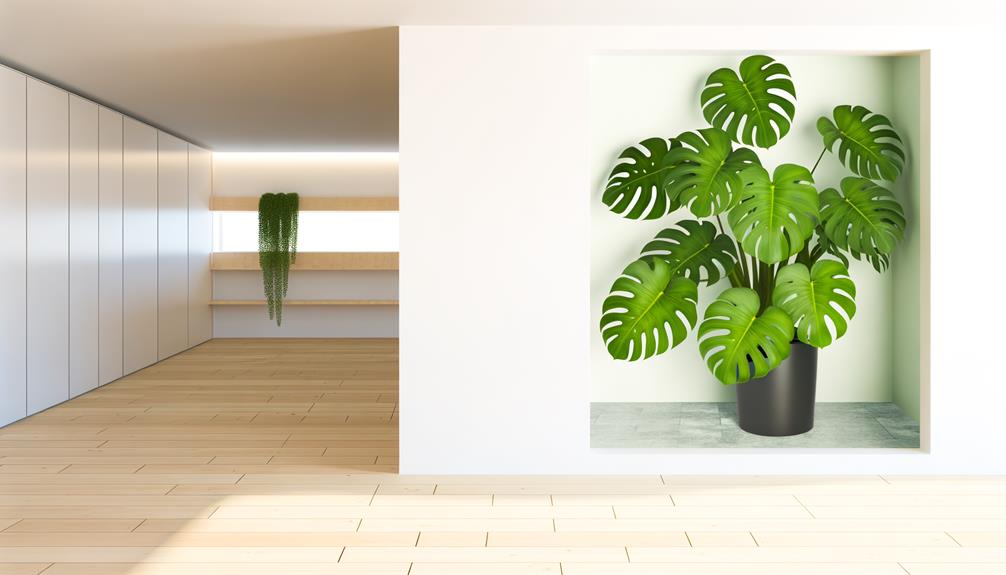
Monstera siltepecana has gained significant popularity in Australia due to its unique fenestrated leaves and adaptability to various indoor environments. You'll find that the species, known for its striking perforations, appeals to plant enthusiasts and interior decorators alike.
The juvenile leaves are lanceolate with prominent silver markings, evolving to more fenestrated foliage as they mature, which is a mesmerizing process to observe.
In Australia, the plant's adaptability to diverse light conditions and tolerance to varying humidity levels make it an ideal choice for homes and offices. The robust climbing nature of Monstera siltepecana also allows it to thrive on trellises or moss poles, enhancing its aesthetic appeal.
Its popularity underscores a growing appreciation for exotic, yet manageable, houseplants down under.
Ideal Growing Conditions
To cultivate Monstera Siltepecana successfully, you'll need to understand its specific light requirements, best soil composition, and appropriate watering frequency.
Ensure it receives bright, indirect sunlight to mimic its native understory habitat. Utilize a well-draining soil mix rich in organic matter, and maintain consistent moisture without overwatering to prevent root rot.
Light Requirements
For best growth, Monstera siltepecana thrives in bright, indirect light, mimicking the dappled sunlight of its native tropical understory. Direct sunlight can cause leaf burn, while insufficient light results in leggy growth and reduced variegation. Aim to provide light levels between 10,000 and 20,000 lux.
To maximize growth potential under ideal light conditions, consider the following:
- Placement: Position your plant near an east or north-facing window.
- Artificial Lighting: Use full-spectrum LED grow lights if natural light is insufficient.
- Light Duration: Maintain a photoperiod of 12-14 hours during the growing season.
- Light Measurement: Use a light meter to accurately gauge light intensity, ensuring it remains within the ideal range.
These steps help replicate the Monstera siltepecana's natural habitat.
Soil and Fertilizer
A well-draining, aerated soil mix rich in organic matter provides the best growing conditions for Monstera siltepecana. You should use a blend containing peat moss, perlite, and pine bark to maintain proper aeration and moisture retention.
The ideal pH range for this plant is between 5.5 and 7.0. Incorporate a slow-release, balanced fertilizer like a 10-10-10 NPK ratio to support steady growth.
During the growing season, feed the plant monthly with a diluted liquid fertilizer to promote lush foliage. Avoid over-fertilizing, as it can lead to nutrient burn and root damage.
Sustaining the right soil and fertilization practices will help your Monstera siltepecana thrive and maintain its striking variegated leaves.
Watering Frequency
Watering Monstera siltepecana requires a balanced approach, ensuring the soil remains consistently moist but not waterlogged to avoid root rot. This epiphytic species, native to tropical forests, thrives in high humidity and well-draining soil mixtures.
To achieve the best hydration, follow these guidelines:
- Soil Moisture: Maintain soil moisture at around 40-60%. Use a moisture meter for accuracy.
- Watering Schedule: Water thoroughly when the top 2-3 inches of soil feel dry. Typically, this means watering every 7-10 days.
- Humidity Levels: Aim for ambient humidity of 60-80%. Regular misting can help achieve this.
- Water Quality: Use filtered or rainwater to avoid salt and mineral buildup, which can harm the plant.
Watering Needs
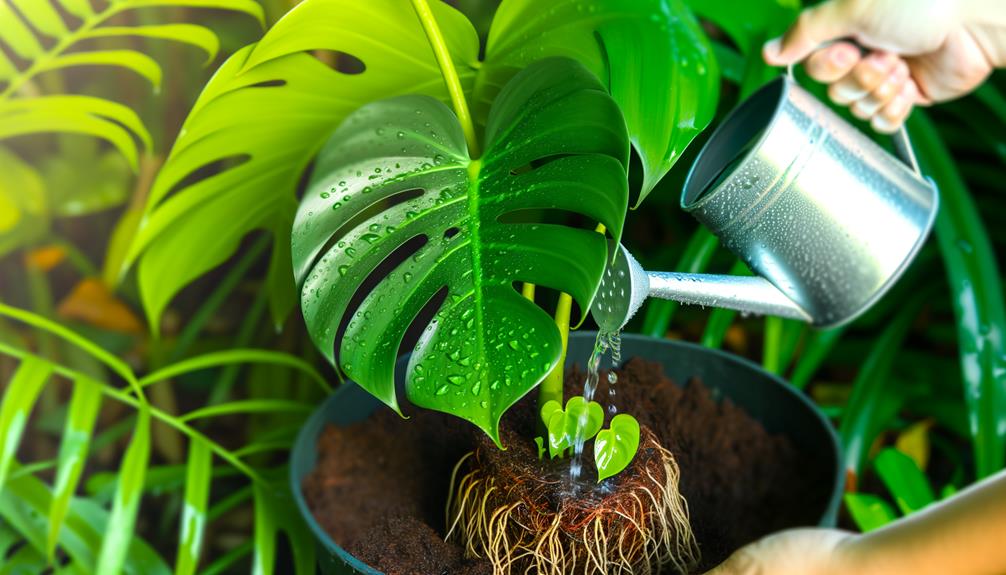
Ensuring Monstera siltepecana receives the right amount of water is essential for its best growth and health. Proper hydration prevents leaf wilting and root rot. You'll want to maintain a balance of moisture, ensuring the substrate is consistently damp but never waterlogged. Test the soil's moisture by inserting your finger about 2 inches (5 cm) deep; it should feel slightly moist.
During the growing season, adjust watering frequency based on ambient humidity and temperature, typically requiring more water in warmer conditions. Avoid chlorinated water as it can harm the plant; use distilled or rainwater instead.
Soil and Fertilization
To complement proper watering, Monstera siltepecana thrives in a well-draining soil mix rich in organic matter, such as a blend of peat moss, perlite, and orchid bark. This mixture guarantees ideal root aeration and moisture retention.
Regular fertilization enhances growth, particularly during the active growing season. Use a balanced, water-soluble fertilizer with an N-P-K ratio of 20-20-20.
Here's a quick guide for soil and fertilization:
- Soil Composition: 40% peat moss, 30% perlite, 30% orchid bark.
- Fertilization Frequency: Feed every 4-6 weeks during spring and summer.
- Fertilizer Type: Use a balanced, water-soluble fertilizer.
- Application Method: Dilute fertilizer to half strength to avoid root burn.
Following these steps guarantees your Monstera siltepecana remains healthy and vibrant.
Common Pests and Diseases
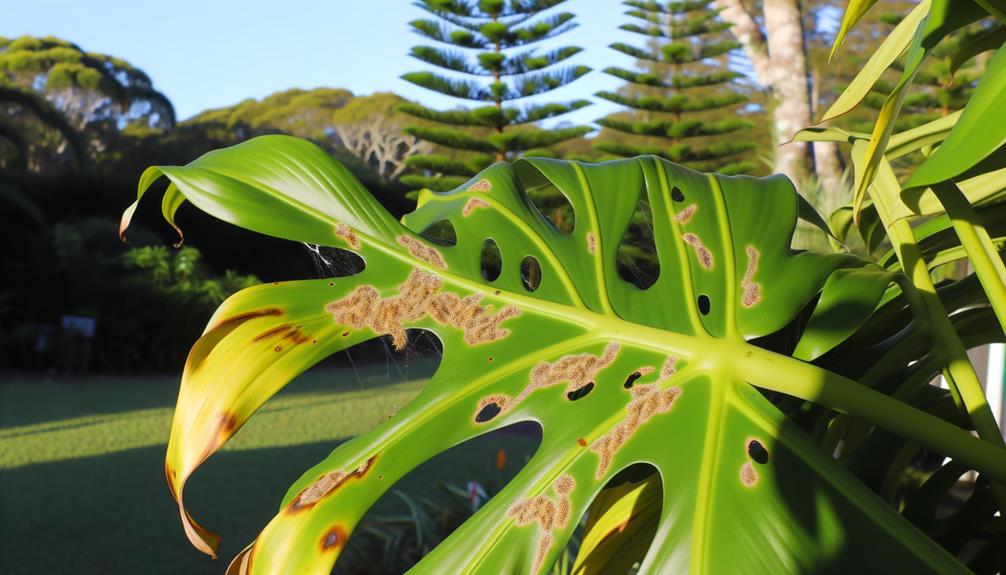
Monstera siltepecana is susceptible to common pests like spider mites (Tetranychidae) and mealybugs (Pseudococcidae), which can cause significant damage if not promptly addressed. Spider mites typically create fine webbing on the undersides of leaves, sucking out plant juices and leading to stippling and leaf discoloration. Mealybugs appear as cottony masses in leaf axils and secrete honeydew, fostering sooty mold and stunted growth.
To manage these pests, inspect your plant regularly, especially new growth areas. Use insecticidal soap or neem oil for treatment, making sure of thorough coverage. Additionally, Monstera siltepecana can suffer from root rot caused by overwatering and poor drainage. To prevent this, maintain well-draining soil and avoid excessive watering.
Your vigilance secures a healthy, thriving plant.
Propagation Tips
Propagating Monstera siltepecana involves taking stem cuttings with at least one node and aerial root. Then, placing them in water or well-draining soil to promote root development. Make sure you're using clean, sterilized tools to prevent infections.
Follow these steps for successful propagation:
- Select a Healthy Stem: Choose a vigorous stem with at least one node (the swollen area where leaves and roots develop) and an aerial root for best growth.
- Cut Below the Node: Use a sharp, sterile knife or scissors to make a clean cut just below the node.
- Prepare the Medium: Place the cutting in a container with filtered water or a pot with a well-draining soil mix.
- Maintain Humidity: Keep the cutting in a humid environment, ideally with 60-70% humidity, to encourage root formation.
Conclusion
To sum up, while Monstera siltepecana's distinctive characteristics and journey from El Salvador to Australia might seem challenging, you can effectively cultivate this beautiful plant.
Proper watering, well-draining soil, and regular fertilization guarantee vigorous growth. Despite possible challenges like pests or diseases, utilizing neem oil or insecticidal soap can handle them efficiently.
With meticulous propagation techniques, you'll appreciate a flourishing Monstera siltepecana, enhancing the natural charm of your Australian garden or indoor area.


